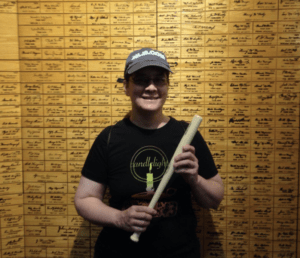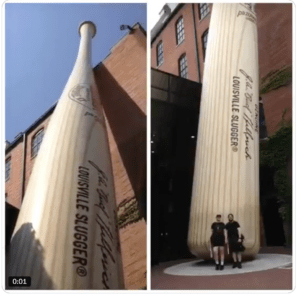We drove across Missouri on Saturday, had dinner in St. Louis, and then continued on the Louisville, Kentucky, where we planned to see the Louisville Slugger Museum in the morning.
On Sundays, the museum opens at 11am, which was also checkout time at our hotel, so we slept as late as we could (it was nearly 3am when we had arrived), checked out a few minutes after 11 and then got our stuff into our car. By the time we walked over to the Louisville Slugger Museum it was 11:20 am and there was a line around the building. In anticipation of eclipse-seekers in need of something to do on Sunday and Monday, the museum was running a two-for-one special, and lots of people were taking them up on it.
I'm now in a massive line for the Louisville Slugger museum. Eclipse seekers exceeded their expectations I think… pic.twitter.com/kteMST3keG
— cecilia tan wilbb (@whyilikebb) August 20, 2017
My companions went in search of some food while I got in line (since we’d slept through hotel breakfast hours). Unfortunately, most of downtown Louisville closes down on Sundays, so the only thing they found was a hot dog cart. Fortunately, this turned out to be the best hot dog cart ever, with smoked beef sausage, bratwurst, and other similar delicacies, served with chili and onions, for a very low price. The perfect food to eat while waiting in line for a baseball attraction, it really hit the spot.
As the line inched along we could look through the windows into the factory and see people being led through the tour. As we neared the main door we suddenly looked up and WHOA there was a huge baseball bat in the courtyard. By huge I mean it was the same size as the smokestack bat outside Yankee Stadium, except this one was actually a giant replica that looked like wood. (Though it wasn’t.)
All told it took about 45 minutes to get through the line and purchase tour tickets. The earliest tour we could get was for 12:50, but that gave us an hour to look at the rest of the museum.
The rest of the museum is completely worth spending an hour looking around. For me, there’s no such thing as too much stuff about Babe Ruth, and I’d never seen the photos of him watching the Kentucky Derby with Ward Hillerich. I got chills seeing Ruth’s original Louisville Slugger contract, a letter of endorsement he sent to Hillerich & Bradsby, and of course some of his bats. One that is on display shows notches cut around the oval trademark, one for each home run. Chills, I tell you, chills.
These notches in Babe Ruth's bat represent home runs hit with it. pic.twitter.com/Eeh7poGI70
— cecilia tan wilbb (@whyilikebb) August 23, 2017
There were also displays on the history of the company, of course. Hillerich originally made a lot of things in the woodworking trade, including butter churns. The first professional they made a bat for was Pete Browning of the Louisville Eclipse baseball team.
Yes, that’s right, on our way to see the Great American Eclipse of 2017, we stopped in the town whose team was called the Eclipse.
Anyway. Pete Browning’s nickname was “The Louisville Slugger” and as he had success with his Louisville-made bat, more and more players wanted one like his. The bat and his nickname became synonymous, and the bat was soon officially named “The Louisville Slugger.”
Mentions of the Eclipse were everywhere! pic.twitter.com/OtRPhvtrGv
— cecilia tan wilbb (@whyilikebb) August 23, 2017
In one of the large rooms of the museum there are drawers in the base of the displays. When you pull them open you discover more treasures: bats used by Lou Gehrig, Ty Cobb, Stan Musial, Roberto Clemente, Joe Tinker, and many others. Fantastic.
The museum is full of things that cement the idea that Hillerich & Bradsby is part of the fabric of major leaugue baseball. The current standings are shown on a board by the ticket window. Two opinion poll questions ask fans to consider whether bat flips and other expressions by the players are part of the game, should be penalized by umpires, etc… and whether baseball should be part of the Olympics.
Voters on a poll at the Louisville Slugger museum think MLB should fully support baseball in the Olympics. pic.twitter.com/ENF1zS3KKK
— cecilia tan wilbb (@whyilikebb) August 23, 2017
Two special exhibits are also on display right now. One is all baseball-themed Lego art which includes Lego portraits of Derek Jeter, Joey Votto, and Buster Posey, Lego action sculptures of batters, pitchers, and baserunners, and recreations of baseball stadiums like Wrigley Field, Busch Stadium, and Milwaukee’s Miller Park, complete with a motorized retractable roof.
Wrigley Field made of Lego! #louisvilleslugger pic.twitter.com/6IzFCGHSKq
— cecilia tan wilbb (@whyilikebb) August 23, 2017
The other one is a painted mural of Hank Aaron and Muhammed Ali with a civil rights theme, asking people what do you fight for? What do you go to bat for? The wall opposite the mural has Post-it notes of people’s answers. I wasn’t expecting a big pro-civil rights statement at the Louisville Slugger Museum but it was really great to see it there. In the wake of the lethal Charlottesville protests (a left wing counter protestor was killed by a right wing white supremacist marcher who rammed her and several others with his car), it feels like we’re rapidly coming to the point where every citizen and every institution will have to choose sides. Are you in favor of a just, inclusive society? Or are you on the Nazi side? History teaches us those are the only choices, and sitting on the sidelines means you side with Nazis. It would seem Louisville Slugger is well aware that American institutions ought to be on the side of democracy and inclusion for all. Bravo.
Even Louisville Slugger believes in equality & inclusion. Thank you @SluggerMuseum for this exhibit! pic.twitter.com/R1uSi4U9ld
— cecilia tan wilbb (@whyilikebb) August 23, 2017
Speaking of which, there was not only a nice display about women in baseball and softball, integrating information about the AAGPBL (All American Girls Professional Baseball League) with modern Olympic softball stars. And sitting in the gift shop selling her books that day was Dr. Kat D. Williams! What a delight to see her there. She and I had never met, but it turns out we’re both involved with the establishment of the new SABR Award, the Dorothy Seymour Mills award, which will be an annual award for a woman (possibly posthumous) for her contributions to baseball (whether women’s baseball or men’s).
I ran into @DrK1943 Dr. Kat Williams at the @SluggerMuseum selling her book on women's baseball. pic.twitter.com/hunnp3byCc
— cecilia tan wilbb (@whyilikebb) August 23, 2017
But I haven’t even told you yet about the factory tour, which is the true highlight of the visit. The factory floor is working all the hours that the museum is open making actual bats. The tour guide demonstrated the old methods of making a bat by hand, that used to take 20 minutes to make each one, and then we also saw the lathes that make amateur and mass marketed bats, and then the two special $250,000 machines that make major league bats and can store all the different bat designs in memory. Previously it was a laborious process to change the machine from, say, the setup for Ben Zobrist’s bats to the settings to make Colin Yelich’s. Now it just takes the push of a button. Another machine saws the knobs and sands the wood, and then an employee has to hand dip the bats into the various paints and finishes.
At the end, every attendee of the tour gets a mini-bat, which is pretty terrific. The tour and museum admission costs $14, and the mini-bat is a $7 retail value. Pretty keen. Completely worth not only the money but the time spent. I could have easily spent another hour poking around after the tour (there are batting cages!) but we had to get going to the next stop on our itinerary, so we bade the big bat adieu.

At the end of the @SluggerMuseum tour they gave us our own mini bats. Here I am at the wall of player signatures. pic.twitter.com/JQq1lFolA1
— cecilia tan wilbb (@whyilikebb) August 23, 2017
Last one from our @Sluggermuseum visit: me and corwin and the giant Louisville Slugger: pic.twitter.com/bbOyMAI636
— cecilia tan wilbb (@whyilikebb) August 24, 2017

Leave a Reply